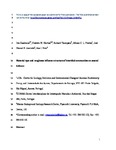Material type and roughness influence structure of inter-tidal communities on coastal defenses
| dc.contributor.author | Cacabelos, E | |
| dc.contributor.author | Martins, GM | |
| dc.contributor.author | Thompson, R | |
| dc.contributor.author | Prestes, ACL | |
| dc.contributor.author | Azevedo, JMN | |
| dc.contributor.author | Neto, AI | |
| dc.date.accessioned | 2016-12-22T14:25:12Z | |
| dc.date.issued | 2016-08 | |
| dc.identifier.issn | 0173-9565 | |
| dc.identifier.issn | 1439-0485 | |
| dc.identifier.uri | http://hdl.handle.net/10026.1/8164 | |
| dc.description.abstract |
<jats:title>Abstract</jats:title><jats:p>On a global scale, urbanization has resulted in substantial proportions of coasts being replaced by artificial structures such as marinas, breakwaters and seawalls. There is broad consensus that coastal defense structures are poor surrogates of the natural habitats that they replace. Here we investigated the effects of the type and roughness of materials used for the construction of artificial structures on the surrounding biota by comparing abundances and distribution of key inter‐tidal taxa between natural shores and coastal defenses. Lower abundances of gastropods and barnacles were found on artificial coastal defense structures (regardless of the material type). At small spatial scales, abundances of key taxa increased with increasing roughness. Our results suggest that the choice of materials used for the construction of coastal defense structures has little effect on community structure <jats:italic>per se</jats:italic>, but that enhanced roughness could make coastal defenses better surrogates of natural habitats by supporting assemblages that are more similar to those found on natural shores.</jats:p> | |
| dc.format.extent | 801-812 | |
| dc.language | en | |
| dc.language.iso | en | |
| dc.publisher | Wiley | |
| dc.subject | Artificial structures | |
| dc.subject | inter-tidal assemblages | |
| dc.subject | macroalgae | |
| dc.subject | marine biodiversity | |
| dc.subject | urbanization | |
| dc.title | Material type and roughness influence structure of inter-tidal communities on coastal defenses | |
| dc.type | journal-article | |
| dc.type | Article | |
| plymouth.author-url | http://gateway.webofknowledge.com/gateway/Gateway.cgi?GWVersion=2&SrcApp=PARTNER_APP&SrcAuth=LinksAMR&KeyUT=WOS:000383606200008&DestLinkType=FullRecord&DestApp=ALL_WOS&UsrCustomerID=11bb513d99f797142bcfeffcc58ea008 | |
| plymouth.issue | 4 | |
| plymouth.volume | 37 | |
| plymouth.publication-status | Published | |
| plymouth.journal | MARINE ECOLOGY-AN EVOLUTIONARY PERSPECTIVE | |
| dc.identifier.doi | 10.1111/maec.12354 | |
| plymouth.organisational-group | /Plymouth | |
| plymouth.organisational-group | /Plymouth/Faculty of Science and Engineering | |
| plymouth.organisational-group | /Plymouth/Faculty of Science and Engineering/School of Biological and Marine Sciences | |
| plymouth.organisational-group | /Plymouth/REF 2021 Researchers by UoA | |
| plymouth.organisational-group | /Plymouth/REF 2021 Researchers by UoA/UoA07 Earth Systems and Environmental Sciences | |
| plymouth.organisational-group | /Plymouth/Research Groups | |
| plymouth.organisational-group | /Plymouth/Research Groups/Marine Institute | |
| plymouth.organisational-group | /Plymouth/Users by role | |
| plymouth.organisational-group | /Plymouth/Users by role/Academics | |
| plymouth.organisational-group | /Plymouth/Users by role/Researchers in ResearchFish submission | |
| dcterms.dateAccepted | 2015-11-28 | |
| dc.rights.embargodate | 2017-8-31 | |
| dc.identifier.eissn | 1439-0485 | |
| dc.rights.embargoperiod | Not known | |
| rioxxterms.versionofrecord | 10.1111/maec.12354 | |
| rioxxterms.licenseref.uri | http://www.rioxx.net/licenses/all-rights-reserved | |
| rioxxterms.licenseref.startdate | 2016-08 | |
| rioxxterms.type | Journal Article/Review |


